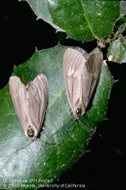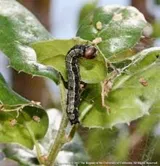By Bill Tietje, UC Cooperative Extension and
Maria Murrietta, Program Coordinator, UC Master Gardeners of SLO County



It’s getting to be that time of year again! The apparent damage the California oak worm causes our native coast live oak trees and the nuisance it creates can be a huge issue if you happen to be near a hot spot for their activity. Last summer and fall, the Master Gardener helpline offices received literally hundreds of calls from the community concerned about their oak trees. Here, in Q/A format, are the main concerns that came out of the phone calls.
Q: Will the worms harm the trees?
A: No! Even complete defoliation is unlikely to harm a healthy tree. Oak trees and oak worms are both native to California oak woodlands. Over millennia, they have learned to live with each other. Like any parasite/host relationship, it is not in the better interest of the parasite to harm its host. It sounds strange, but one could look at the worms as benefiting the tree by removing some foliage during a low-rainfall year, thereby limiting the loss of water through transpiration. If your otherwise healthy tree has lost some or all of its leaves, new leaves will grow on your oak trees next spring.
Q: Will the worms feed on plants other than Coast Live Oak trees?
A: Rarely! The caterpillars usually eat only coast live oak leaves. In an outbreak year, the caterpillars may feed temporarily on non-oak species.
Q: How can I get rid of the worms?
A: There is no practical way to get rid of the worms. Pesticide applications are usually not warranted and can be very expensive. Broad-spectrum pesticides, if used, would also knock down beneficial predator populations. BT (Bacillus thuringiensis), a biological control, can be sprayed onto the tree foliage. When the oak worms eat the leaves, they die within a few days. However, for the control to be successful the timing of the BT application is critical—and of course, it’s not easy or cheap to treat a large tree. These applications usually are not worth the effort and cost.
Q: How long will the worms be around this year?
A: Typically oak worms feed from April to September.
Q: What’s the prognosis for this year (2014)?
A: California oak worm populations tend to build up over a couple years and then, if conditions are right, there is an outbreak that lasts one year or two. The relatively dry winter this year followed by an early spring has resulted in high survival rate of overwintering eggs and early development of the eggs. This set of circumstances may jumpstart the production of worms—and, although it’s too early to say for sure, this summer and fall could see its share of oak worms! The good news is that the natural predators of the oak worm also build up when the worms are abundant. Parasitic wasps, the spined soldier bug and two tachinid parasitic flies are among the most important insect predators. These and other natural predators will not be able to knock down large numbers of worms, but they can help manage small populations and may help to prevent large outbreaks. ,The worms are obviously capable of eating themselves out of house and home; therefore, high levels of infestation should not occur year after year. The bottom line: when there is an outbreak, there will likely be a depression. (Of course, Mother Nature doesn’t always abide by the rules!)
Q: Will the worms damage my home?
A: Well, not really. Although the worms may crawl onto your house or even into the house, they cannot damage the house. However, they can make a mess. The best thing is to keep any possible entrance closed and tolerate them as best you can. More than likely, the California oak worm will be around for a year or so and then not bother you again for at least several years.
References
UC Oaks. UC ANR Welcome - UC Oaks | Oak Woodland Management
Swiecki, Tedmund and Elizabeth Bernhardt. 2006. A Field Guide To Insects And Diseases Of California Oaks. PDF. USDA. A Field Guide to Insects and Diseases of California Oaks
UC IPM Pest Notes: California Oakworm. CaOakWormPN 04_14_2009.indd
